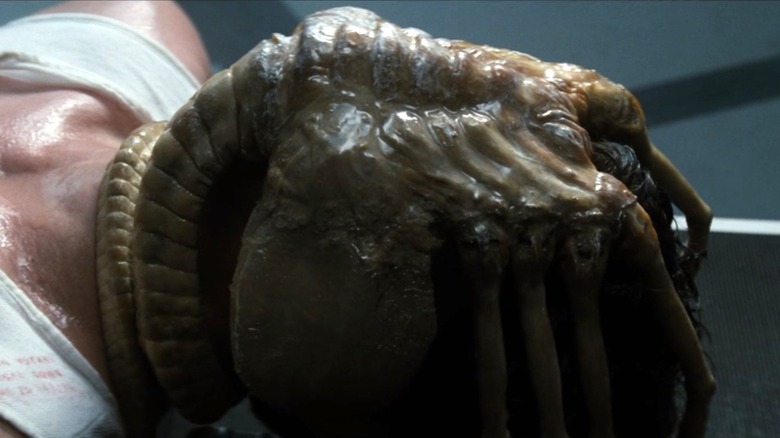Alien's First Facehugger Design Was Originally Bigger And Grosser
It turns out that the already frightening Facehugger xenomorph from the director Ridley Scott's 1979 sci-fi horror classic "Alien" was actually scaled back a bit from its original design by artist H.R. Giger.
In a TikTok post by Alien_Theory, Giger describes in a video interview his earlier iterations of the Facehugger, which was based on a description of the creature sent to him by "Alien" co-writer Dan O'Bannon. "The Facehugger — that was the first thing I did for Dan O'Bannon when he sent me, I think, about $1,000 to do some paintings for 'Alien,'" the Swiss artist recalled in the video. "He's gave me some explanations and drawings. He said that he's jumping out of a big egg ... I though that must be quite a big monster, so I did an enormous Facehugger."
The TikTok post then displays one of Geiger's paintings of the Stage 1 Xenomorph, and it's a lot larger than the final version. Instead of hugging the victim's face with its tentacles, the mid-section of the creature, if lying down, could cover the person's entire chest. The Facehugger's head and face is also notably visible, and the painting shows what appears to be its nose or tongue down the throat of the victim. The video then transitions to a second painting that is much more graphic and disgusting, as Giger depicts an organ on the Xenomorph that implants the Chestburster instead.
Giger revised the tentacles of the Facehugger to look more like fingers
In the Alien_Theory TikTok video, H.R. Giger noted that Dan O'Bannon eventually asked him to scale down the size of the Facehugger xenomorph. At that point, the artist arrived at the look of the alien that fans would eventually see in Ridley Scott's movie, which was a lot less graphic than his original concept art.
To begin with, Giger used the creature's tentacles as finger-like mechanisms, so it grasps the victim's head. "I think something with human hands is always very scary. So, I had fingers — the long fingers — as the most important part of the Facehugger," the artist said. "Then I had its part, the little sexual, like, the tube that this beast has to put in the mouth."
Of course, James Cameron, the king of sequels, took over the director's reigns from Ridley Scott for his 1986 "Alien" follow-up, "Aliens." Yet while "Aliens" mainly concentrated on much larger versions of the xenomorphs, the Facehugger was back and twice as terrifying than it was in the original film.
Practical visual effects helped the Facehugger become a character in Aliens
In a production featurette about bringing the creature to life in "Aliens," visual effects legend Stan Winston and his team members described the behind-the-scenes efforts of a harrowing lab room sequence where two of the menacing Facehuggers try to latch onto Lt. Ellen Ripley (Sigourney Weaver) and the young orphan Newt (Carrie Henn).
"In order to create the illusion of these two Facehuggers, which are now loose in that room, [we] created a half-dozen different forms of this creature so that it could have a performance and become a character," Winston said. "[We] didn't change the design [but] extended the design [to] change what it could do as an actor."
As a result, the Facehugger now had complete mobility to do much more. Thanks to some complex practical visual effects, Winston said the Facehuggers' fingers could used to crawl and reach at Newt and Ripley. Of course, since "Aliens" was filmed in the mid-1980s, no CGI was involved in bringing the Facehuggers to life. "[They were] operated, literally, by six or seven puppeteers just getting those fingers doing everything they had to do ... It's a very, very extensive, animatronic cable-operated effect."


